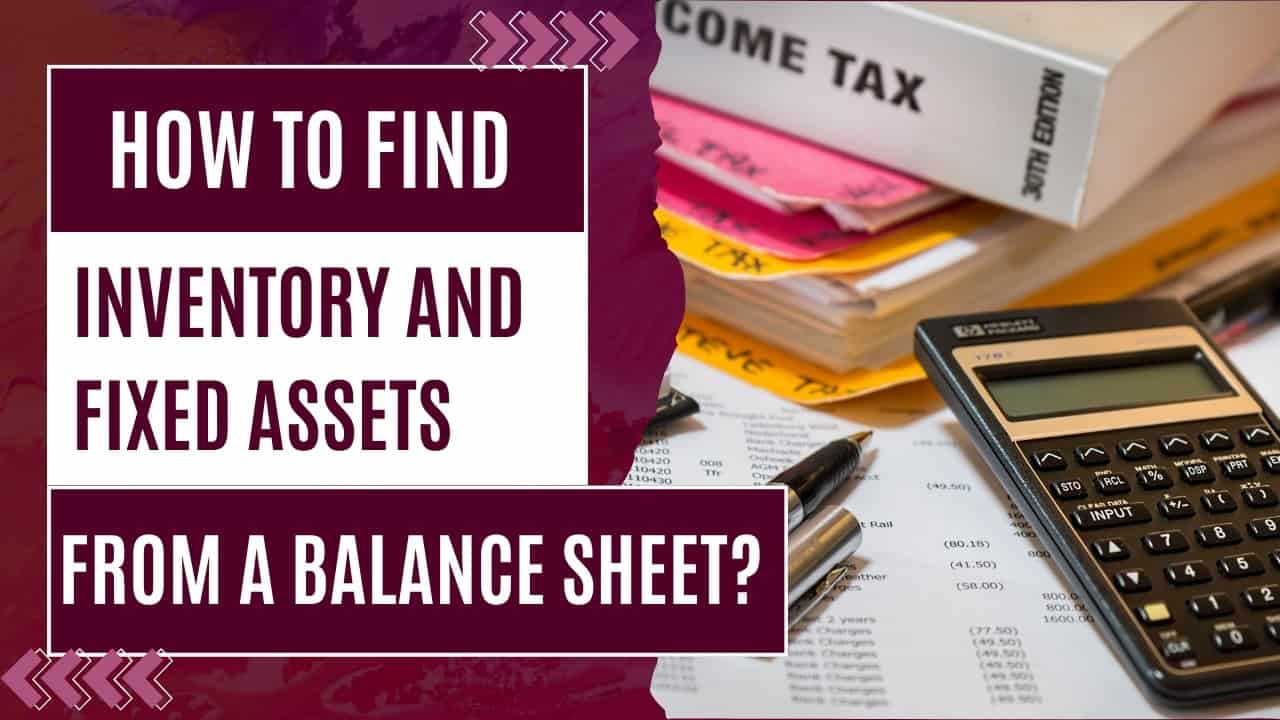How to Find Inventory and Fixed Assets from a Balance Sheet?
So, you’re looking to crack the code on balance sheets, huh? You’re not alone. Understanding how to find inventory and fixed assets from a balance sheet can be a game-changer, whether you’re a business owner, an investor, or just a curious mind. Balance sheets might look intimidating with their columns of numbers and financial jargon, but once you get the hang of it, it’s like reading a book about the financial health of a company. Let’s dive right in!
Introduction to Balance Sheets
Definition of a Balance Sheet
Think of a balance sheet as a snapshot of a company’s financial standing at a specific point in time. It’s one of the key financial statements, alongside the income statement and cash flow statement, used to gauge how well a business is doing.
Purpose of a Balance Sheet
The purpose of a balance sheet is to provide a clear picture of what a company owns (assets), what it owes (liabilities), and the value left over for the owners (equity). It’s all about balance—hence the name.
Key Components
- Assets: What the company owns.
- Liabilities: What the company owes.
- Equity: The owners’ stake in the company.
Understanding Assets
Definition of Assets
An organization’s assets are resources that generate economic benefits in the future.They are like the building blocks of a company’s value.
Types of Assets
- Current Assets: Current assets are short-term assets that a business expects to convert into cash within one year.
- Non-Current Assets: These are long-term assets that a company plans to hold onto for more than a year.
Current Assets
Definition and Characteristics
Current assets are those that can be quickly turned into cash within a short period, typically within a year. They are essential for the company’s day-to-day financial activities.
Examples of Current Assets
- Inventory: Goods available for sale.
- Accounts Receivable: Amounts owed by customers to the company.
- Cash and Cash Equivalents: Cash on hand or assets that can be quickly converted to cash.
Inventory
Definition of Inventory
Inventory includes raw materials, work-in-progress, and finished goods that are ready for sale. It’s a key component of a company’s current assets.
Types of Inventory
- Raw Materials: Basic materials used in production.
- Work-in-Progress: Items that are partially completed.
- Finished Goods: Products ready for sale.
Location on the Balance Sheet
Inventory is typically listed under current assets on the balance sheet, reflecting its liquidity and short-term nature.
Importance of Inventory in Financial Analysis
Inventory management is crucial because it affects a company’s profitability and cash flow. Proper inventory levels ensure smooth operations and customer satisfaction without over-investing in stock.
Valuation Methods
- FIFO (First In, First Out): Assumes the oldest inventory items are sold first.
- LIFO (Last In, First Out): Assumes that the newest inventory is sold first.
- Weighted Average: Uses an average cost for all inventory items.
Impact of Inventory Valuation on Financial Statements
The method used to value inventory can significantly impact the cost of goods sold and, consequently, the net income.
Non-Current Assets
Definition and Characteristics
Non-current assets are long-term investments that a company does not plan to convert into cash within a year. They represent significant investments in the business.
Examples of Non-Current Assets
- Fixed Assets: Property, plant, and equipment.
- Long-term Investments: Stocks, bonds, or other investments held for an extended period.
- Intangible Assets: Patents, trademarks, and goodwill.
Fixed Assets
Definition of Fixed Assets
Fixed assets are long-term tangible assets used in the operation of a business. They are not meant for sale but to provide long-term benefits through their use.
Types of Fixed Assets
- Property: Land and buildings.
- Plant: Manufacturing facilities.
- Equipment: Machinery, vehicles, and tools.
Location on the Balance Sheet
Fixed assets are listed under non-current assets on the balance sheet, usually after current assets.
Importance of Fixed Assets in Financial Analysis
Fixed assets are crucial for generating revenue. They are often a significant part of a company’s investment and operational capabilities.
Acquisition and Capitalization
When a company acquires a fixed asset, it capitalizes the cost, meaning it records the asset on the balance sheet rather than expensing it immediately.
Depreciation
- Definition and Purpose: Depreciation allocates the cost of a fixed asset over its useful life.
- Depreciation Methods:
- Straight-Line: Evenly spreads the cost over the asset’s useful life.
- Declining Balance: Accelerated method that expenses more in the early years.
- Units of Production: Based on usage or production levels.
Impact of Depreciation on Financial Statements
Depreciation affects both the balance sheet and income statement. It reduces the book value of assets and records as an expense, impacting net income.
Asset Valuation
Methods of Valuation for Inventory and Fixed Assets
- Historical Cost: The original cost of the asset.
- Fair Value: The current market value of the asset.
Impairment of Assets
If an asset’s market value drops below its book value, the company must record an impairment loss.
Revaluation of Assets
Some assets are revalued to reflect their current market value rather than historical cost.
Financial Statements Analysis
Role of the Balance Sheet in Financial Analysis
The balance sheet is a vital tool for financial analysis, providing insights into a company’s financial health and stability.
Relationship with Income Statement and Cash Flow Statement
The balance sheet works in tandem with the income statement and cash flow statement to give a complete picture of a company’s financial performance.
Key Ratios Involving Inventory and Fixed Assets
- Inventory Turnover Ratio: Measures how quickly inventory is sold.
- Fixed Asset Turnover Ratio: Indicates how efficiently fixed assets generate sales.
- Current Ratio: Assesses a company’s ability to pay short-term liabilities with current assets.
- Quick Ratio: The current ratio excludes inventory from current assets, unlike the current ratio.
Accounting Standards and Principles
GAAP (Generally Accepted Accounting Principles)
GAAP provides guidelines for financial reporting in the U.S., ensuring consistency and transparency.
IFRS (International Financial Reporting Standards)
IFRS is the global standard for financial reporting, used in over 120 countries.
Relevance of Accounting Standards to Inventory and Fixed Assets
Accounting standards dictate how inventory and fixed assets are recorded and reported, impacting financial statements and analysis.
Practical Examples and Case Studies
Real-World Examples of Balance Sheets
Looking at real-world examples of balance sheets can help you understand how companies report their inventory and fixed assets.
Case Studies Demonstrating Inventory and Fixed Assets Analysis
Case studies can provide practical insights into how companies manage and analyze their inventory and fixed assets.
Practical Tips for Identifying and Valuing Inventory and Fixed Assets
- Tip 1: Always start with the current assets section for inventory.
- Tip 2: Look under non-current assets for fixed assets.
- Tip 3: Check the notes to financial statements for additional details on valuation methods.
Common Issues and Challenges
Common Mistakes in Identifying Inventory and Fixed Assets
- Confusing current and non-current assets.
- Misinterpreting valuation methods.
Challenges in Valuation and Depreciation
Valuing inventory and fixed assets accurately can be challenging, especially with fluctuating market conditions.
How to Address and Resolve These Issues
- Training and Education: Ensure that accounting staff are well-trained in GAAP and IFRS standards.
- Regular Reviews: Conduct regular reviews and audits to ensure accuracy.
Conclusion
Summary of Key Points
We’ve covered a lot of ground! From defining what a balance sheet is to understanding how to find inventory and fixed assets from a balance sheet, you now have a comprehensive guide.
Importance of Accurate Inventory and Fixed Asset Reporting
Accurate reporting of inventory and fixed assets is crucial for financial transparency and decision-making. It ensures that stakeholders have a clear and accurate picture of the company’s financial health.
Final Tips for Analysis
When analyzing a balance sheet, always pay close attention to the valuation methods used for inventory and fixed assets. Look for notes that provide additional context and details. And remember, practice makes perfect— the more balance sheets you analyze, the more proficient you’ll become.
By now, you should feel more confident in how to find inventory and fixed assets from a balance sheet. Whether you’re preparing to invest in a company or just trying to understand your own business better, this knowledge is invaluable.
If you need professional help with your financial analysis or have any questions about managing your assets, consider reaching out to A&I Financials. Our team of experienced accountants is here to ensure your financial records are accurate and insightful. We offer a range of services tailored to meet your needs, from bookkeeping to detailed financial analysis. To learn more about how we can help, contact us today!
FAQs on How to Find Inventory and Fixed Assets from a Balance Sheet
A balance sheet is composed of three main sections: assets, liabilities, and equity. Assets include everything the company owns, liabilities cover what the company owes, and equity represents the owners’ stake in the company.
Inventory is listed under current assets on the balance sheet. It’s usually one of the first items in this section, providing insight into the goods available for sale.
The types of inventory reported include raw materials, work-in-progress, and finished goods. These are all categorized under current assets, reflecting their expected conversion into cash within a year.
A balance sheet lists fixed assets, such as property, plant, and equipment, under non-current assets. They represent long-term investments that the company uses in its operations and plans to hold for more than a year.
Accurate reporting of inventory and fixed assets is crucial for financial transparency and decision-making. It ensures stakeholders have a clear and precise understanding of the company’s financial health, which is essential for investments, audits, and strategic planning.






